AUDI A4 2016 Owners Manual
Manufacturer: AUDI, Model Year: 2016, Model line: A4, Model: AUDI A4 2016Pages: 278, PDF Size: 70.26 MB
Page 131 of 278
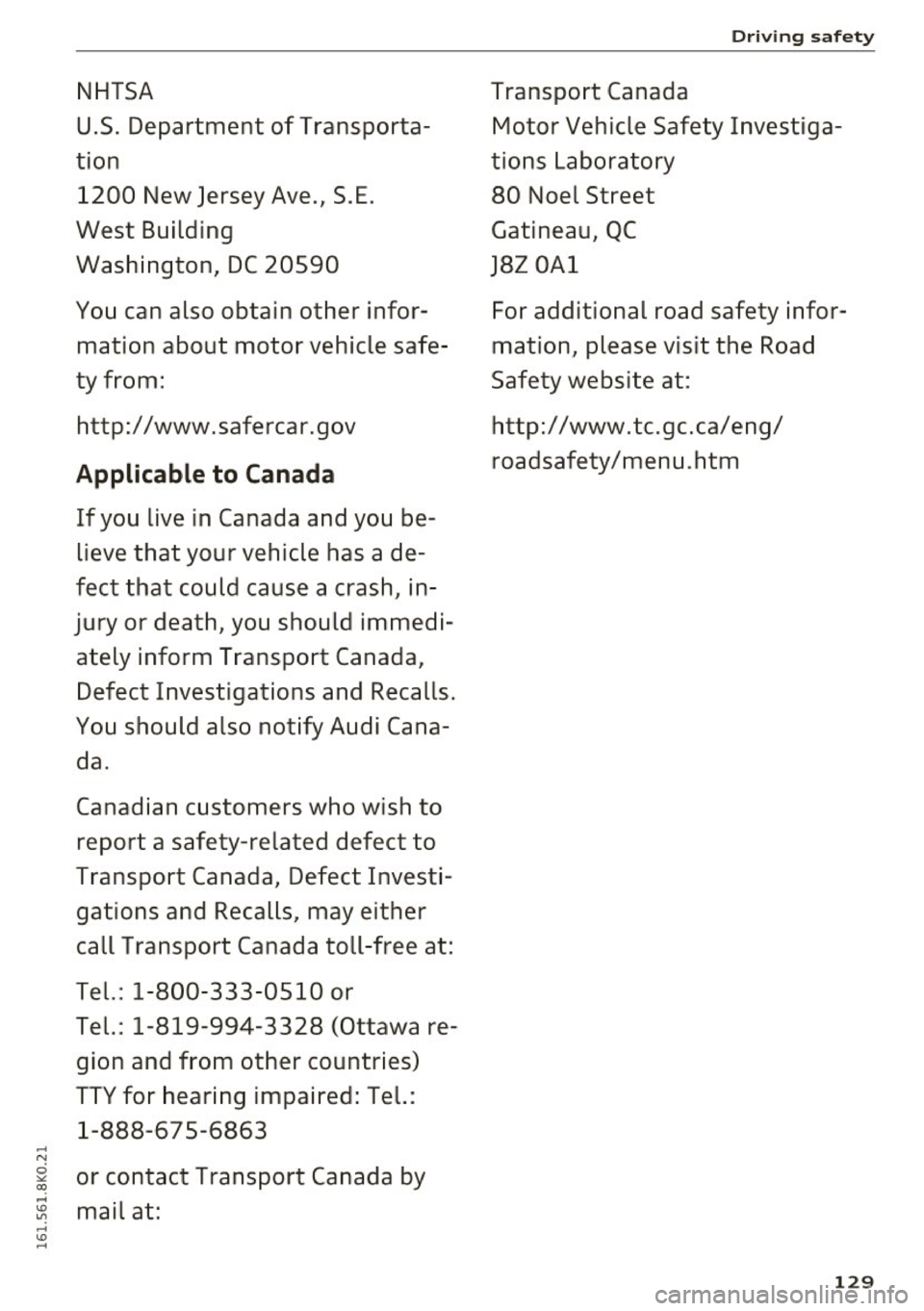
... N
NHTSA
U.S. Department of Transporta
tion 1200 New Jersey Ave., S .E.
West Building
Washington, DC 20590
You can also obtain other infor mation about motor vehicle safe
ty from:
http:/ /www.safercar.gov
Applicable to Canad a
If you live in Canada and you be
lieve that your vehicle has a de
fect that could cause a crash, in
jury or death, you should immedi
ately inform Transport Canada,
Defect Investigations and Recalls .
You should also notify Audi Cana da.
Canadian customers who wish to
report a safety-related defect to
Transport Canada, Defect Investi
gations and Recalls, may either
call Transport Canada toll-free at:
Tel. : 1-800-333 -05 10 or
Tel.: 1-819-994-3328 (Ottawa re
gion and from other countries)
TTY for hearing impaired: Tel.:
1 -888-67 5-6863
~ or contact Transport Canada by
...
~ mail at:
Driving safety
Transpo rt Canada
Motor Vehicle Safety Investiga
tions Laboratory
80 Noel Street
Gatineau, QC
J8Z 0Al
F or additional road safety infor
mation, please visit the Road
Safety website at:
http:/ /www.tc.gc.ca/eng/
roadsafety/menu .htm
1 29
Page 132 of 278
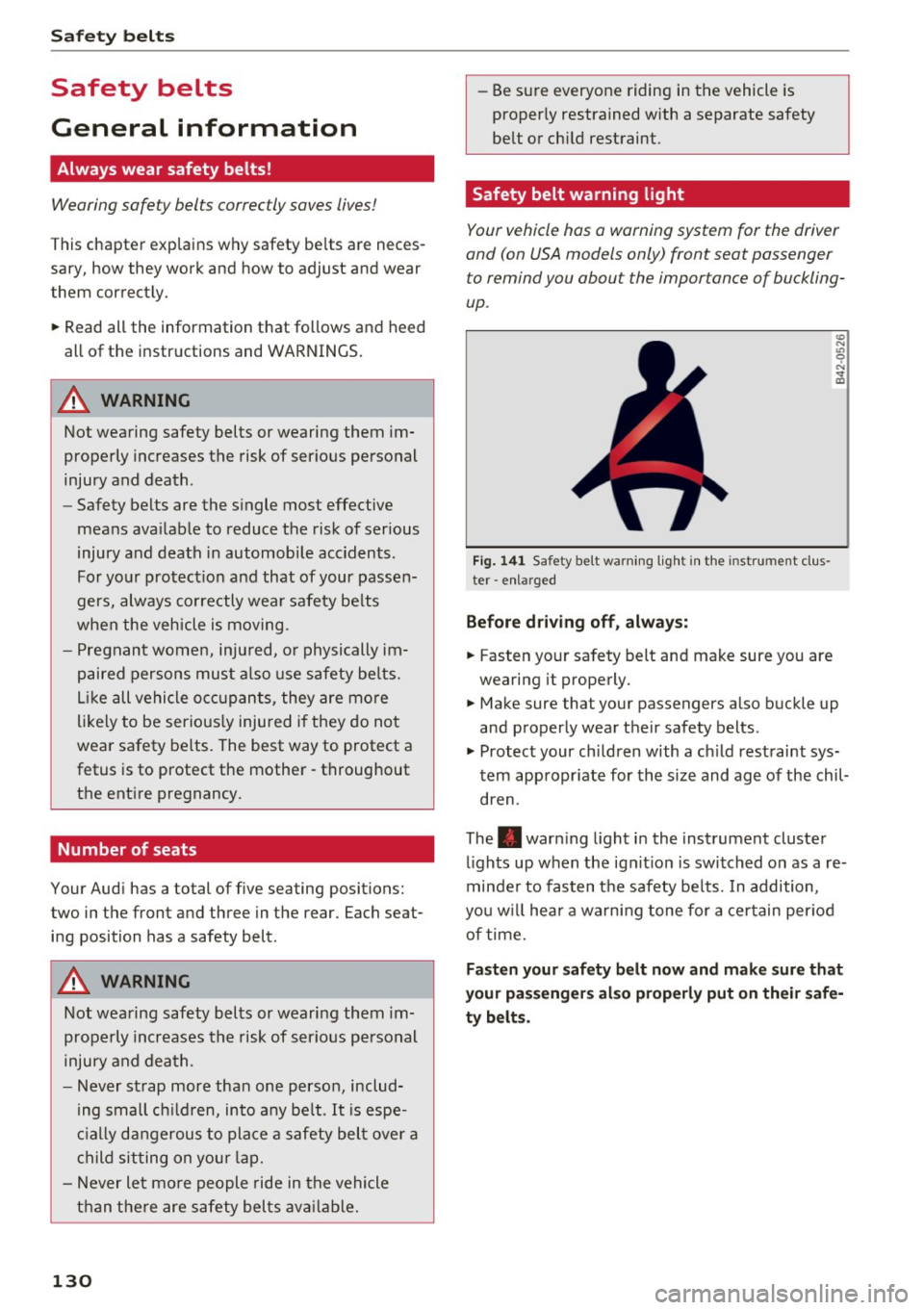
Safety belt s
Safety belts
General information
Always wear safety belts!
Wearing safe ty belts correctly saves lives!
This chapte r explains why safety be lts a re neces
sary, how they work and how to adjust and wear
them correct ly.
.. Read all the information that follows and heed
all of the instructions and WARNINGS.
&_ WARNING
Not wea ring safety belts or wearing them im
properly increases the risk of ser ious personal
injury and dea th .
- Safety belts are the s ingle most effective
mea ns ava ilab le to reduce the risk of serious
injury and dea th in automob ile accidents .
For yo ur protect ion and that of your passe n
gers, alw ays co rre ctly wea r sa fety be lt s
when the veh icle is moving .
- Pregnant wom en, in ju re d, o r physically i m
paired persons mus t also use s afety be lts.
L ik e all vehi cle o ccu pants, they are mo re
li kely to be serio usly injure d if th ey do no t
wea r safety be lts. The best way to protect a
fetus is to protect the mothe r -th roughout
the ent ire pregnancy .
Number of seats
Your Audi has a total of five seating positions:
two in the front and three in the rear. Each seat
i n g position has a safety belt.
&_ WARNING
N ot wea ring safety bel ts or weari ng them im
properly increases th e r isk of ser ious personal
inju ry and dea th.
- N ever st rap more tha n one perso n, includ
ing small ch ildren, into a ny be lt .
It is espe
ci ally dan gerous to pla ce a sa fety bel t over a
c hild s itting on you r lap.
- N ever le t mo re people ride in t he vehicle
t h an t he re are saf ety bel ts availab le.
130
-Be sure everyone riding in the vehicle is
properly restrained with a separate safety
be lt or ch ild restraint.
Safety belt warning light
Your vehicle has a warning system for the driver
and (on USA models only) front seat passenger
to remind you about the importance of buckling
up .
Fig. 141 Safety belt wa rning lig ht in th e in st rument clu s
ter -enl arged
Before driv ing off , alway s:
.. Fasten your sa fety belt and make sure you are
wearing it prope rly.
(0
"'
"' 0 N
and proper ly wea r th eir safety belts .
.. Protec t your ch ildren with a ch ild rest raint sys
tem app ropr iate for the size and age of the chil
dren .
The . war ning light i n the instrument cluste r
l ights up when the ig nition is swi tched on as a re
minde r to fas ten t he safety be lts. In addition,
yo u w ill hea r a wa rn ing tone for a ce rt ain per io d
of time.
Fasten your safety belt now and make sure that
your passengers also properly put on their safe
ty belts.
Page 133 of 278
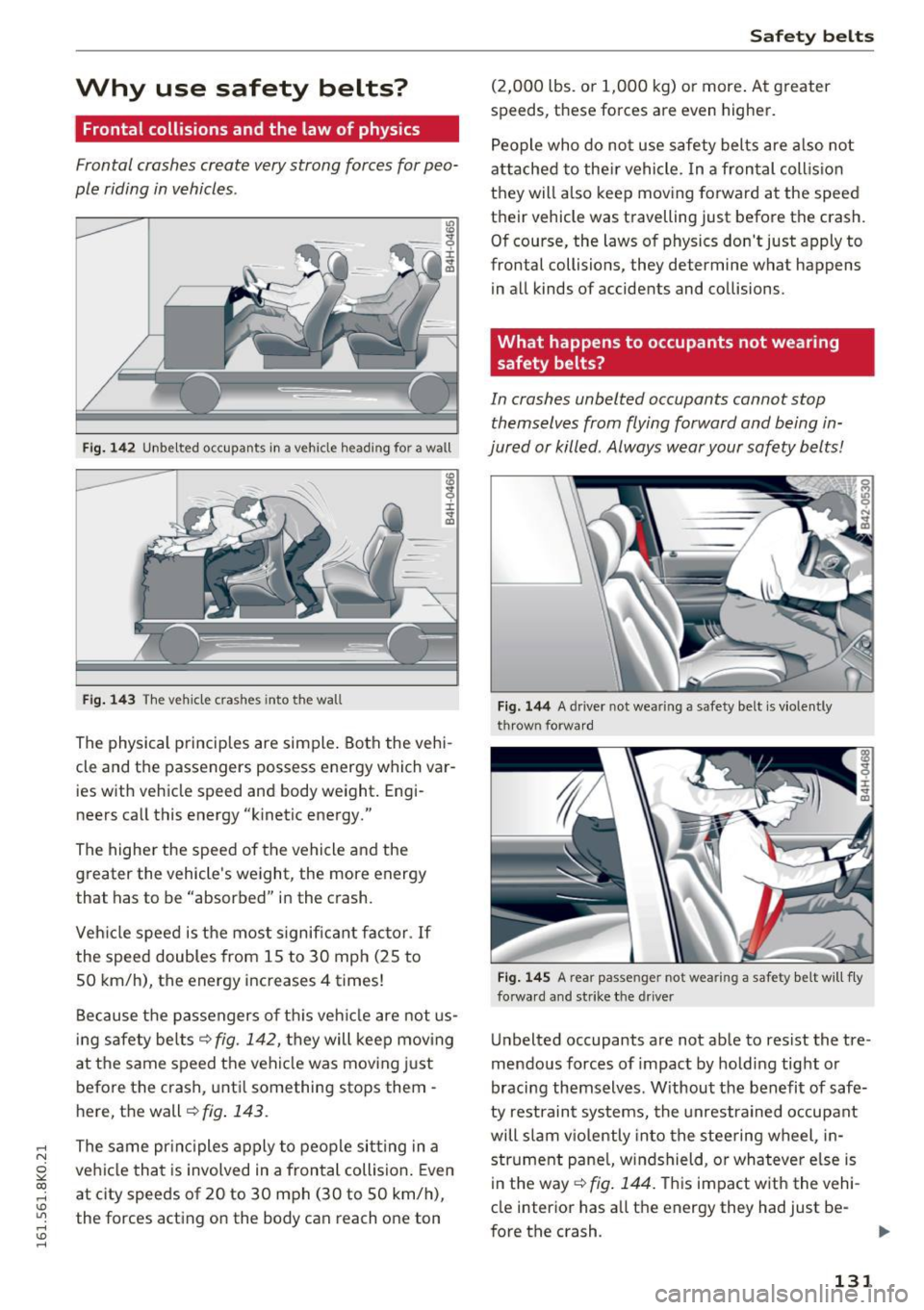
,....,
N
0
""' CX) ,....,
I.Cl U"I ,....,
I.Cl ,....,
Why use safety belts?
Frontal collisions and the law of physics
Frontal crashes create very strong forces for peo
ple riding in vehicles .
Fig. 142 Unbelted occupants in a vehicle heading for a wall
Fig . 143 The vehicle crashes into the wall
CD
~ ±
cle and the passengers possess energy which var
ies with vehicle speed and body weight. Engi
neers call this energy "kinetic energy."
The higher the speed of the vehicle and the
greater the vehicle's weight, the more energy
that has to be "absorbed" in the crash.
Veh icle speed is the most significant factor.
If
the speed doubles from 15 to 30 mph (25 to
50 km/h), the energy increases 4 times!
Because the passengers of this vehicle are not us
ing safety belts¢
fig. 142, they will keep mov ing
at the same speed the vehicle was moving just
before the crash, until something stops them -
here, the wall
¢fig. 143.
The same principles apply to people sitting in a
vehicle that is involved in a frontal collision. Even
at city speeds of 20 to 30 mph (30 to 50 km/h),
the forces acting on the body can reach one ton
Safety belts
(2,000 lbs. o r 1,000 kg) or more . At greater
speeds, these forces are even higher.
People who do not use safety belts are also not
attached to their vehicle. In a frontal collision
they will also keep moving forward at the speed
their vehicle was travelling just before the crash.
Of course, the laws of physics don't just apply to
frontal collisions, they determine what happens in all kinds of accidents and collisions.
What happens to occupants not wearing
safety belts?
In crashes unbelted occupants cannot stop
themselves from flying forward and being in
jured or killed. Always wear your safety belts!
Fig. 144 A driver not wearing a safety belt is v iolently
thrown forward
Fig. 145 A rear passenger not wearing a safety belt will f ly
forwa rd and strike the
driver
Unbelted occupants are not able to resist the tre
mendous forces of impact by holding tight or
bracing themselves . Without the benefit of safe
ty restraint systems, the unrestrained occupant
will slam viol ently into the steering wheel, in
strument panel, windshield, or whatever else is
in the way
¢fi g. 144. This impact with the vehi
cle interior has all the energy they had just be-
fore the crash.
Ill>-
131
Page 134 of 278
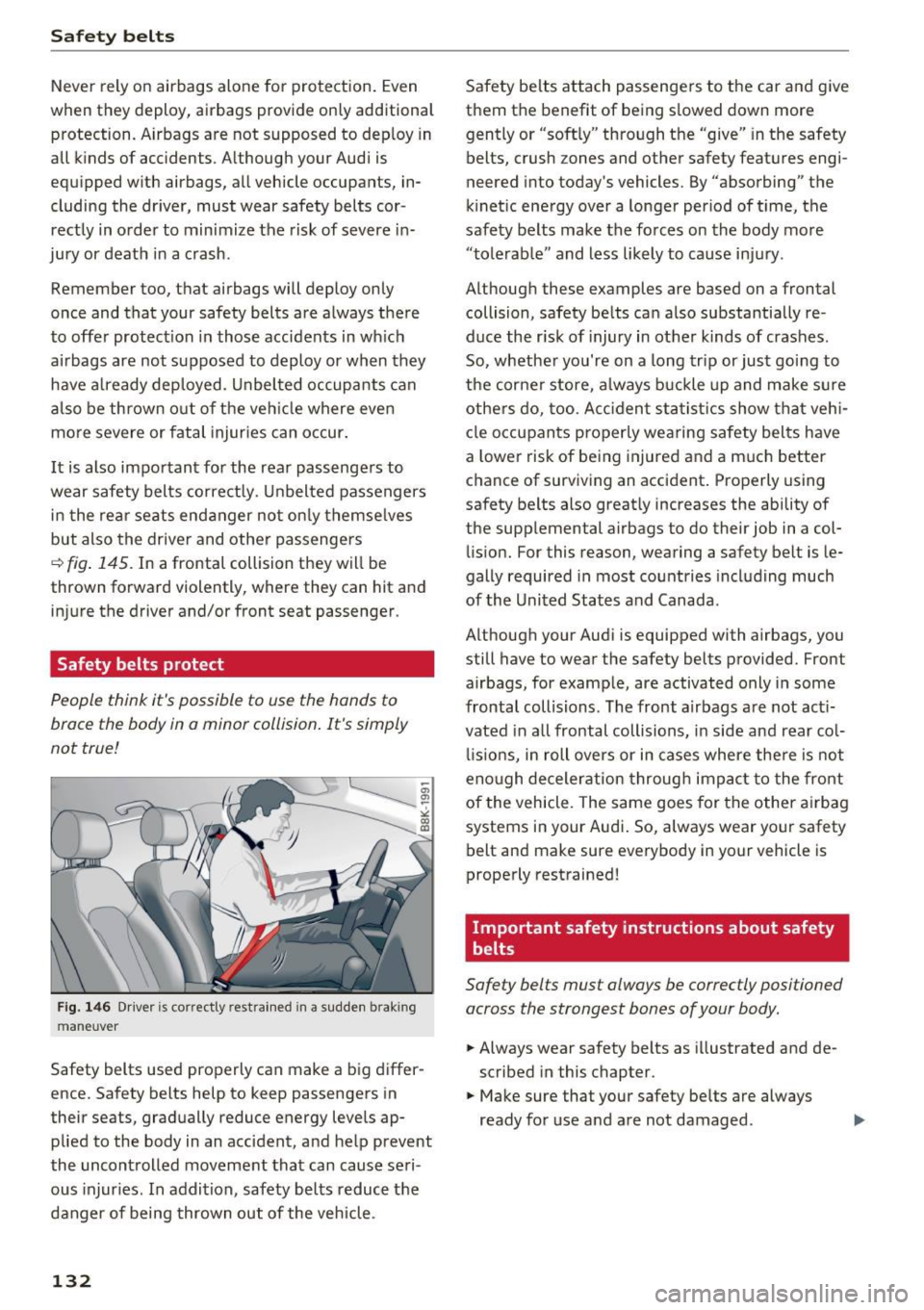
Safe ty belts
Never rely o n airbags alone for protection . Even
when they deploy, airbags provide only additional
protection. A irbags are not supposed to dep loy in
all kinds of accidents. A lthough your Audi is
equipped w ith airbags, all vehicle occupants, in
cluding the driver, must wear safety belts cor
rectly in order to minimize the risk of severe in
jury or death in a crash .
Remember too, that airbags will deploy only
once and that your safety belts are a lways there
to offer protect ion in those accidents in wh ic h
airbags are not supposed to deploy or when they
have a lready dep loyed. Unbel ted occupants can
a lso be thrown o ut of the veh icle where eve n
mo re severe or fatal injur ies can occur .
It is also important for the rear pass enge rs to
wear safety belts co rrectly. Unbelted passengers
i n t he rea r seats endanger no t on ly themse lves
but also the drive r and other passengers
~ fig . 145. In a frontal collision they will be
thrown forward violently, where they can hit and
in jure the driver and/or front seat passenger.
Safety belts protect
People think it's possible to use the hands to
brace the body in a minor collision . It's simply
not true!
F ig . 14 6 Driver is correctly restrai ned in a sudde n braking
m aneuver
Safety belts used properly can make a b ig d iffer
ence. Safety belts help to keep passengers in
their seats, gradually reduce energy levels ap
plied to the body in an accident, and he lp prevent
the uncont rolled moveme nt that can cause seri
ous injur ies. In addition, safety belts reduce the
danger of being thrown out of the veh icle .
132
Safety be lts attach passengers to the car an d give
them the benefit of being s lowed down more
gently or "soft ly" thro ugh the "give" in the safety
belts, crush zones and other safety feat ures engi
neered into today's vehicles. By "absorbing" the
k inet ic energy over a longer per iod of t ime, the
safety belts make the forces on the body more
"tole rab le" and less likely to cause inj ury.
Although these examples are based on a frontal
collision, safety be lts ca n also substantially re
duce the r isk o f injury in ot her kinds of crashes.
So, whethe r yo u're on a long trip or just going to
the cor ne r store, a lways b uckle up and make s ure
othe rs do, too. Ac ciden t stat ist ics show that veh i
cl e o ccupants prope rly wearing safety bel ts have
a lowe r risk of being injured and a m uch better
chance of surviving an acc ident . Properly using
safety be lts also great ly increases the ability of
the supp lemental airbags to do their job in a col
li sion. For this reason, wearing a safety belt is le
gally required in most countries including much
of the United States and Canada .
Although your Aud i is equipped with airbags, you
still have to wear the safety belts provided. Front
airbags, for examp le, are activated only in some
frontal collisions. The front airbags are not act i
vated in all frontal collisions, in side and rear co l
li sions, in roll overs or in cases where the re is not
eno ugh deceleration throug h impa ct to the front
of the vehicle. The same goes for the other a irbag
systems in your Audi. So, always wear your safety
belt and make sure everybody in your vehicle is
properly rest rained!
Important safety instructions about safety
belts
Safety belts must always be correctly positioned
across the strongest bones of your body.
.,. Always wear safety belts as illustrated and de
scribed in this chapter.
.,. Make sure that your safety be lts are always
ready fo r use a nd are not damaged .
Page 135 of 278
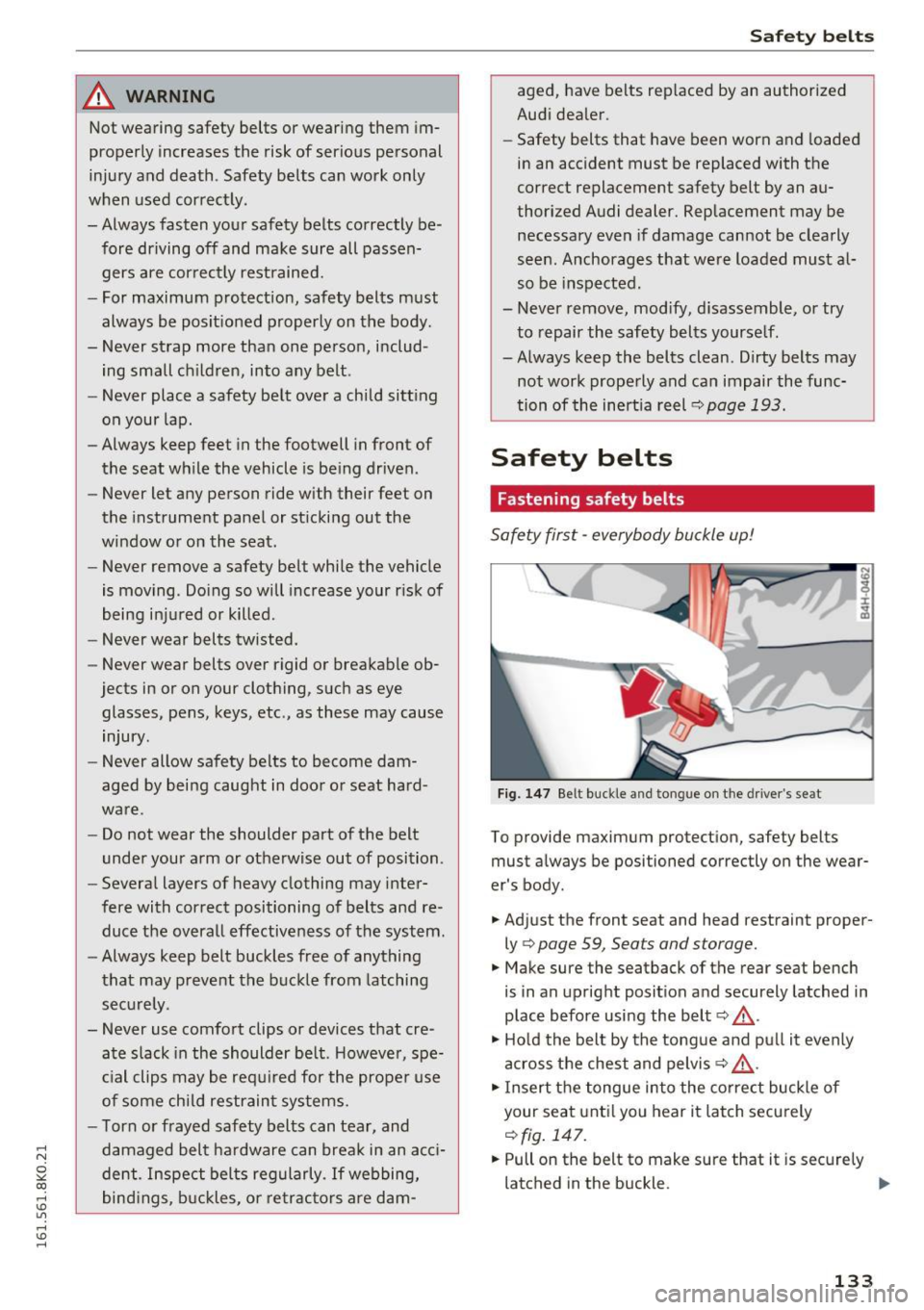
,....,
N
0
""' ex:, ,....,
I.Cl U"I ,....,
I.Cl ,....,
_& WARNING
Not wearing safety belts or wearing them im
properly increases the risk of serious personal
injury and death . Safety belts can work only
when used correct ly.
-Always fasten your safety belts correctly be fore driving off and make sure all passen
gers are cor rect ly restrained.
- For maximum protection, safety belts must
always be posit ioned properly on the body .
- Never strap more than one person, includ
ing small ch ildren, into any belt .
- Never place a safety belt over a child sitt ing
on your lap.
- Always keep feet in the footwell in front of
the seat wh ile the vehicle is being driven.
- Never let any person ride w ith their feet on
the instrument panel or st icking out the
window or on the seat .
- Never remove a safety belt while the vehicle
is moving . Do ing so will increase your risk of
being injured or k illed.
- Never wear belts twisted.
- Never wear belts over rigid or breakable ob-
jects in or on your clothing, such as eye
glasses, pens, keys, etc., as these may cause
injury.
- Never allow safety belts to become dam
aged by being caught in door or seat hard
ware.
- Do not wear the shoulder part of the belt
under your arm or otherwise out of position .
- Several layers of heavy clothing may inter
fere with correct positioning of belts and re
duce the overall effectiveness of the system.
- Always keep belt buckles free of anything
that may prevent the buckle from latching
securely .
- Never use comfort clips or devices that cre
ate slack in the shoulder be lt . However, spe
cial clips may be requ ired for the proper use
of some child restraint systems.
- Torn or frayed safety belts can tear, and
damaged belt ha rdware can break in an acc i
dent. Inspect belts regularly.
If webbing,
bind ings, buckles, or re tractors are dam-
Safet y bel ts
aged, have belts rep laced by an authorized
Aud i dea ler .
- Safety belts that have been worn and loaded
in an accident must be replaced with the
correct replacement safety belt by an au
thorized Audi dealer. Replacement may be
necessary even if damage cannot be clearly
seen. Anchorages that were loaded must al
so be inspected.
- Never remove, mod ify, d isassemble, or try
to repair the safety belts yourse lf.
-Always keep the belts clean . Dirty belts may
not work properly and can impair the func
tion of the inert ia reel¢
page 193.
Safety belts
Fastening safety belts
Safety first -everybody buckle up!
F ig. 14 7 Belt buckle and tongu e on t he d river' s se at
To provide maximum protection, safety belts
must always be positioned correctly on the wear
er 's body .
... Adjust the front seat and head restraint proper
ly
¢ page 59, Seats and storage.
... Make sure the seatback of the rear seat bench
is in an upright posit ion a nd securely latched in
place before using the belt
Q _&. .
"' Ho ld the bel t by the tongue and pu ll it evenly
across the chest and pelvis¢_&. .
... Insert the tongue in to the correct buckle of
your seat unti l you hear it latch securely
Qfig. 147.
... Pull on the belt to make sure that it is securely
latched in the buckle .
IIJ,,
133
Page 136 of 278
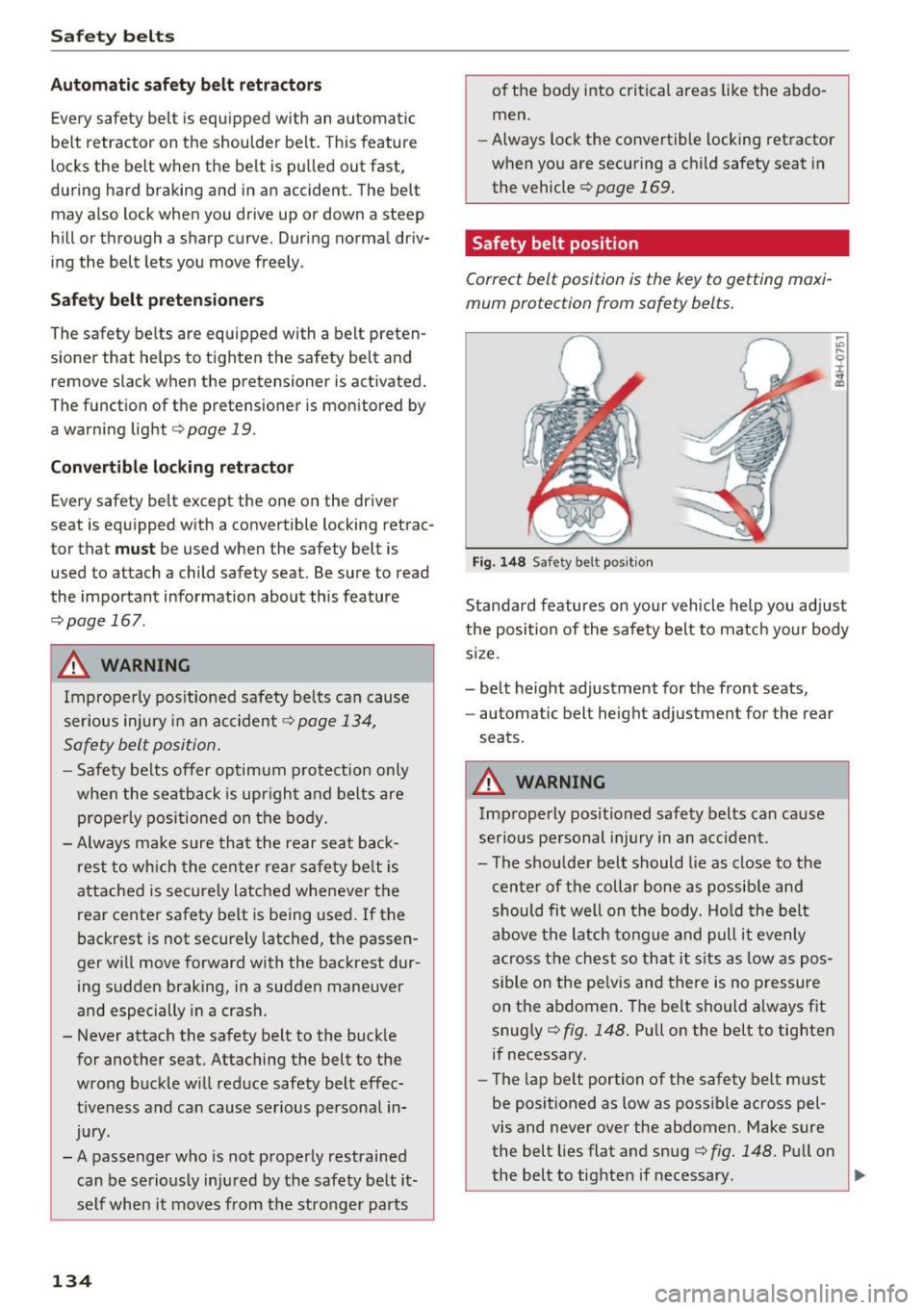
Safe ty belts
Autom ati c s afet y belt retr actors
Every safety belt is equ ipped with an automa tic
be lt retractor on the shoulder belt. This feature
locks the belt when the belt is pulled out fast,
during hard braking and in a n accident . The belt
may a lso lock when you drive up or down a steep
hill or through a sharp curve. Dur ing normal driv
ing the belt lets you
move freely .
Safety belt p ret en sion ers
The safety belts are equipped with a belt preten
sioner that helps to t ighten the safety belt and
remove slack when the pretensioner is activated.
The function of the pretensioner is mon itored by
a warning light
r:::') page 19.
Convertib le loc king retracto r
Every safety be lt except the one on the driver
seat is equipped with a convertible locking retrac
tor that
mus t be used when the safety belt is
used to attach a child safety seat. Be sure to read
the impo rtant information about this feature
c:;, page 167.
.&_ WARNING
Imprope rly pos itioned safety be lts can cause
ser ious injury in an accident
c:;, page 134,
Safety belt position.
- Safety belts offer optimum protection only
when the seatback is upright and belts are
properly positioned on the body.
- Always make sure that the rear seat back
rest to which the center rea r safety belt is
attached is secure ly latched whenever the
rear center safety belt is being used. If the
backrest is not securely latched, the passen
ger will move forward with the backrest dur
ing sudden braking, in a sudden maneuver
and especially in a crash.
- Never attach the safety belt to the buckle for another seat. Attaching the belt to the
wrong buckle will reduce safety belt effec
tiveness and can cause serious persona l in
jury.
- A passenger who is not properly restrained can be seriously in jured by the safety be lt it
self when it moves from the stronger parts
134
of the body into critical areas like the abdo men.
- Always lock the convertible locking retractor
when you are securing a child safety seat in
the vehicle
c:;, page 169.
Safety belt position
Correct belt position is the key to getting maxi
mum protection from safety belts .
Fig. 148 Safety belt posit ion
-"' .... 9 I ... a,
Standard features on your vehicle help you adjust
the position of the safety belt to match your body
s ize.
- belt height adjustment for the front seats,
- automatic belt height adjustment for the rear
seats .
.&_ WARNING
Improperly positioned safety belts can cause
serious personal injury in an acc ident.
- The shou lder belt should lie as close to the
center of the collar bone as possible and
should fi t well on t he body. Hold the belt
above the latch to ng ue and pull it evenly
across the chest so tha t it s its as low as pos
sible on the pe lvis and there is no pressure
on the abdomen . The belt sho uld a lways f it
snug ly
c:;, fig. 148 . Pull on the belt to tig hten
if necessary.
- The lap be lt portion of the safety belt must
be positioned as low as poss ible across pel
vis and never over the abdomen. Make sure the belt lies flat and snug
c:;, fig. 148. Pull on
the belt to tighten if necessary. .,.
Page 137 of 278
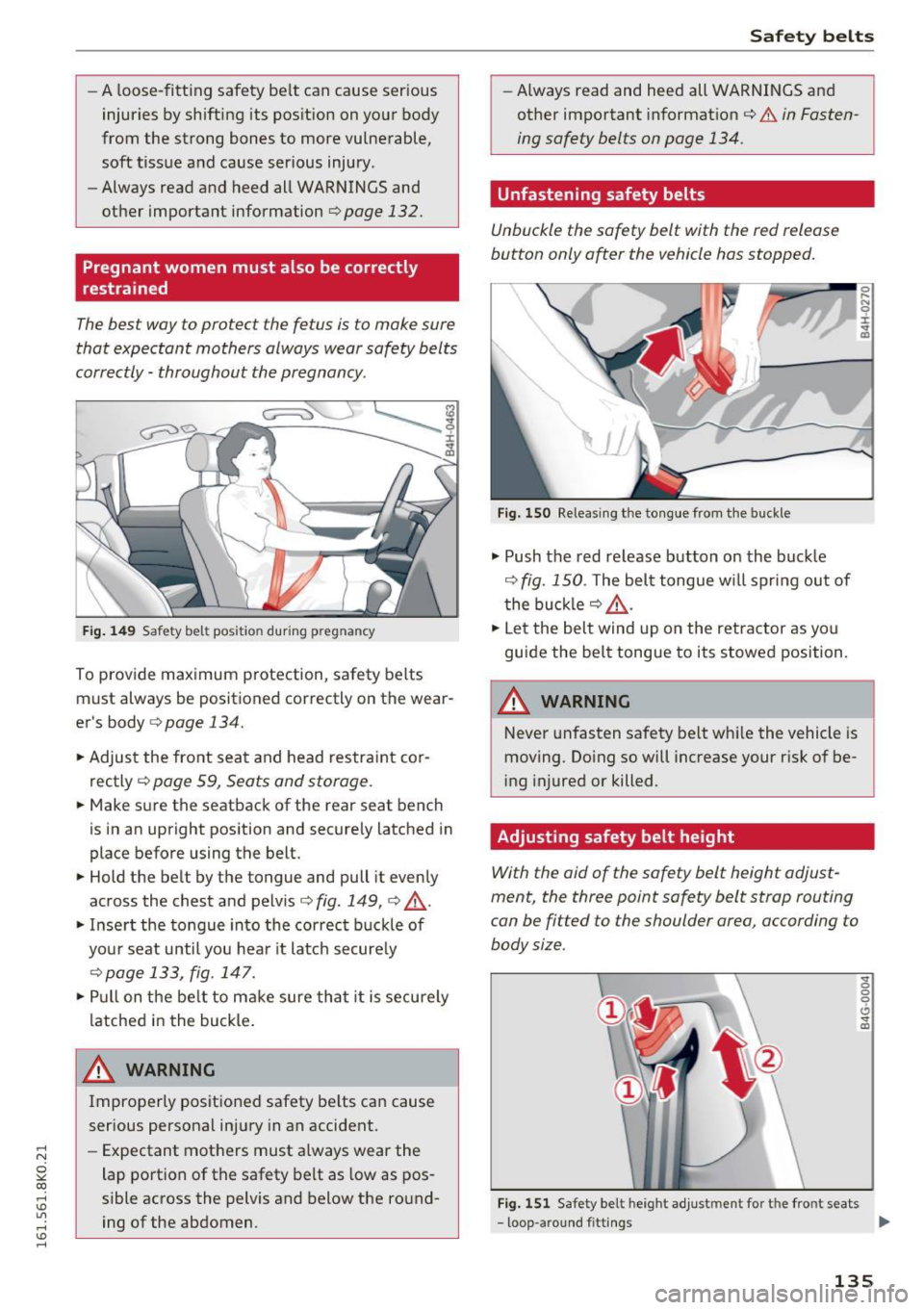
,....,
N
0
""' CX) ,....,
I.Cl U"I ,....,
I.Cl ,....,
-A loose-fitting safety be lt can cause serious
injuries by shifting its pos ition on your body
from the strong bones to more vulnerable,
soft tissue and cause serious injury .
- Always read and heed all WARNINGS and
other important information
c!) page 132.
Pregnant women must also be correctly
restrained
The bes t way to pro tec t the fe tus is to make sure
that expectant mothers always wear safety belts
correctly -throughout the pregnancy .
Fig . 14 9 Safe ty belt pos itio n dur ing pregn an cy
To provide max imum p rotection, safety belts
must always be positioned correctly on the wear
er's body
c:> page 134.
.,. Adjust the front seat and head restraint cor
rectly ¢
page 59 , Seats and storage .
.,. Make su re th e seatback of the rear seat bench
is in an upright position and secure ly latched in
place before using the belt.
.,. Hold the belt by the tongue and pull it even ly
across the chest and pelv is
c:> fig. 149, c:> ,& .
.,. Inse rt the tongue into the cor rec t buckle of
you r seat until you hea r it latch securely
,:!)page 133, fig . 147.
.,. Pull on the be lt to m ake sure that it is securely
latched in the bu ck le .
& WARNING
Improperly positioned safety be lts can cause
ser ious personal inj ury in an accident.
- Expectant mothers must a lways wear the
lap portion of the safety belt as low as pos
sible across the pelvis and below the round ing of the abdomen .
Safety bel ts
-Always read and heed all WARNINGS and
other important informat ion ¢
A in Fasten
ing safety belts on page 134.
Unfastening safety belts
Unbuckle the safety belt with the red release
button only o~er the vehicle has stopped.
.,
JJ
Fig. 150 Releasi ng t he to ngue from the buckle
.,. Push the red re lease but ton on the buck le
r:!) fig. 150 . The belt tongue w ill spr ing out of
t he buck le
c:> ,& .
.,. Let the belt wind up on the retra ctor as yo u
guide the belt tongue to its stowed posit ion.
& WARNING
Never unfasten safety belt whi le the vehicle is
moving . Do ing so will increase your r isk of be
i ng injured or killed .
Adjusting safety belt height
With the aid of the safety belt height adjust
ment, the three point safety belt strap rout ing
can be fi tted to the shoulder area, according to
body size .
Fig. 1 51 Safety belt height a dju stm ent fo r th e fro nt seat s
0 .... N 0
:i: .., co
... 0 0
0
6 ... co
-loop -a round fittings Ill>
135
Page 138 of 278

Safety belts
The shou lder belt should lie as close to the center
of the collar bone as possib le and should fit well
on the body
c::> A in Safety belt position on
page 134.
"' Push
the loop -around fittings up c::> fig. 151 @ ,
or
"'squeeze together the (D button, and push the
loop-around fittings down@.
"'Pull the belt to make sure that the upper at
tachment is properly engaged .
A WARNING
Always read and heed all WARNINGS and oth er important informat ion
c::> page 132.
(D Tips
With the front seats, the height adjustment of the seat can also be used to adjust the po
sition of the safety belts.
Improperly worn safety belts
Incorrectly positioned safety belts can cause se
vere injuries.
Wearing safety belts improperly can cause seri
ous injury or death. Safety belts can only work
when they are correctly positioned on the body.
Improper seating positions reduce the effect ive
ness of safety belts and will even inc rease the
risk of injury and death by mov ing the safety belt
to cr it ica l areas of the body. Improper seating
positions a lso increase the risk of serious injury
and death when an airbag deploys and strikes an
occupant who is not in the correct seating pos i
tion. A driver is responsible for the safety of all
veh icle occupants and especially for children.
Therefore:
"' Never permit anyone to assume an incorrect
sitting position in the vehicle while traveling
c>_& .
A WARNING
Improperly worn safety belts increase the risk
of serious personal injury and death whenever
a vehicle is being used.
136
- Always make sure that all vehicle occupants
are correctly restrained and stay in a correct
seating position whenever the vehicle is be
ing used.
- Always read and heed all WARNINGS and
other important informat ion
c::> page 132.
Belt tensioners
How safety belt pretensioners work
In front, side and rear-end collisions above a
particular severity, safety belts ore tensioned au tomatically.
The safety belts are equipped w ith safety belt
pretensioners . The system is activated by sensors
i n front, side and rear-end collisions of great se
verity . This t igh tens the belt and takes up belt
s lack
c::> & in Service and disposal of safety belt
pretensioner on page 137.
Tak ing up the s lack
helps to reduce forward occupant movement dur
ing a collis ion.
(D Note
Never let the belt remain over a rear seatback
that has been folded forward .
@ Tips
The safety belt pretensioner can only be acti
vated once.
- Th e safety belt pretensioners do not deploy
in minor frontal, side and rear-end colli
sions.
- In the case of a side crash, the safety belt
pretensioners will activate on the driver's or
front passenger's sides only, depending on
wh ich side of the vehicle the crash occurs.
- When the safety belt pretensioners are acti
vated, a fine dust is released. This is normal
and is not caused by a fire in the vehicle.
- The relevant safety requirements must be
observed when the vehicle or components
of the system are scrapped. An authorized
Audi dealer or qualified workshop is familiar
with these regulations and will be pleased
to pass on the information to you. .,_
Page 139 of 278
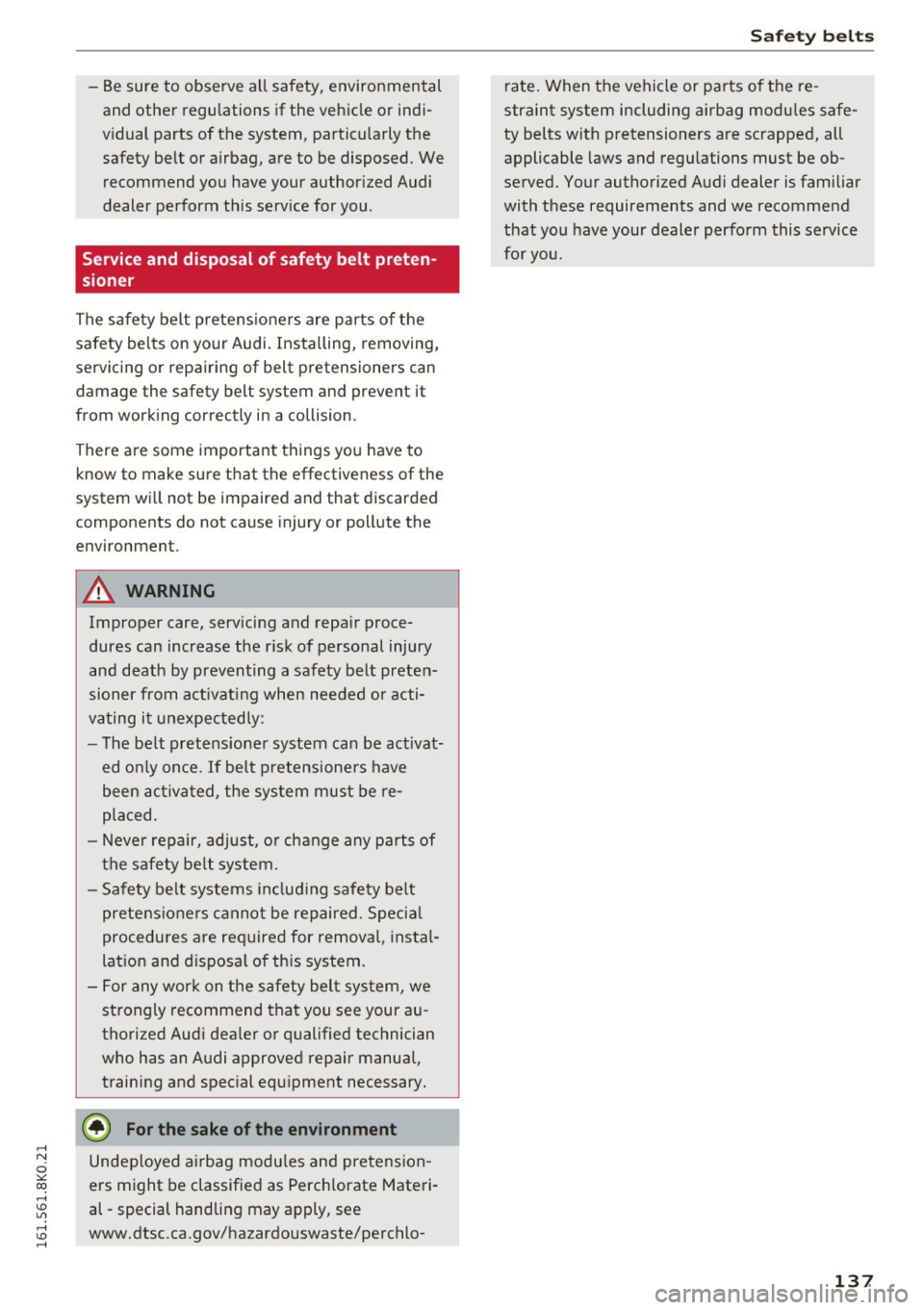
..... N
0 ::..:: co .....
and other regulations if the vehicle or indi
v idual parts of the system, particularly the
safety be lt or airbag, are to be disposed. We
recommend you have your author ized Audi
dealer perform this serv ice for you.
Service and disposal of safety belt preten
sioner
The safety belt pretens ione rs are parts of the
safety be lts on yo ur Audi. Installing, removing,
servicing or repairing of belt pretensioners can
damage the safety belt system and prevent it
from work ing correctly in a collision .
There are some important things you have to
know to make sure that the effectiveness of the
system wi ll not be impaired and that discarded
components do not cause injury or poll ute the
environment.
A WARNING
Improper care, serv icing and repa ir proce
dures can increase the r isk of personal injury
and death by preventing a safety be lt preten
sioner from activating when needed or acti
vating i t unexpectedly:
- The be lt pretensione r system can be act ivat
ed only once.
If belt pretensione rs have
been ac tiva ted, the system must be re
placed.
- Never repair, adjust, or change any parts of
the s afety be lt system.
- Safe ty bel t systems in cl ud ing safe ty belt
pretens ioners cannot be repaired. Specia l
procedu res are req uired for removal, insta l
lat ion and disposa l of this system.
- For any wor k on the safety belt system, we
strongly recommend that you see your au
thorized Audi dea ler o r qualified technician
who has an Audi approved repair manual,
train ing and special equipment necessary.
@ For the sake of the environment
Undep loyed airbag modu les and pretension
ers might be classified as Perch lorate Materi
al -special handling may apply, see
www.dtsc.ca.gov/hazardouswaste/perchlo-
S afet y be lts
rate. When the vehicle or parts of the re
straint system including airbag modu les safe
ty belts with pretensioners are scrapped, all
applicable laws and regu lations must be ob
served. Your authorized Audi dealer is familiar
with these requirements and we recommend
that you have your dealer perform this service
for you.
137
Page 140 of 278
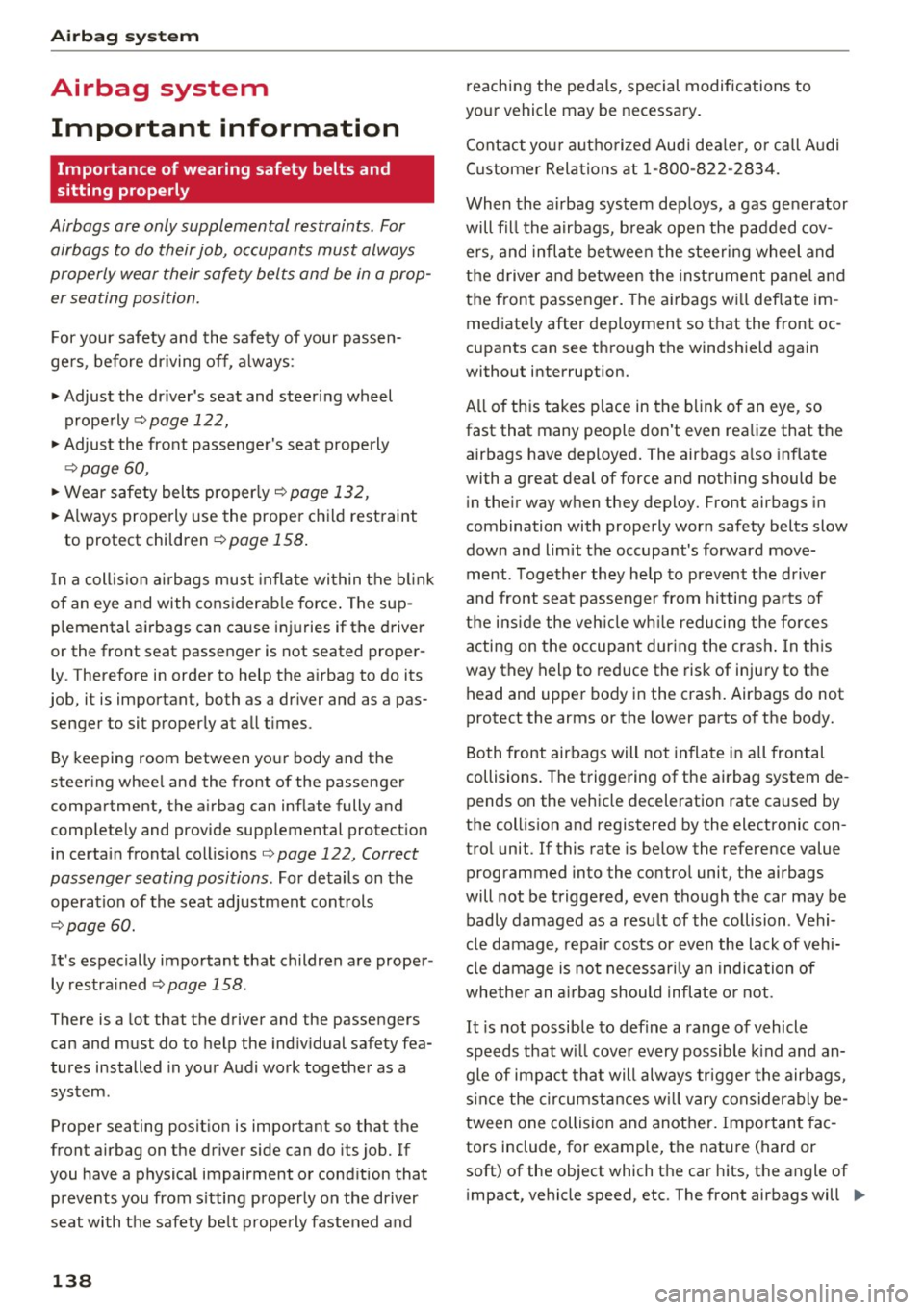
Airbag syste m
Airbag system
Important information
Importance of wearing safety belts and
sitting properly
Airbags are only supplemental restraints . For
airbags to do their job, occupants must always
properly wear their safety belts and be in a prop
er seating position.
For your safety and the safety of your passen
ge rs , before driving off, always :
"' Adjust the driver's seat and steering wheel
properly ¢
page 122,
"'Adjust the front passenge r's seat properly
¢ page 60,
"'Wear safety belts p roperly ¢ page 132 ,
"'Always properly use the proper child restraint
to protect children
¢ page 158.
In a coll is io n airbags must inflate wi thin the b link
of an eye and with cons iderable force . The sup
p lemental airbags can cause injuries if the driver
or the front seat passenger is not s eated proper ·
Ly. T herefore in order to help the airbag to do its
job, it is important, both as a dr iver and as a pas
senger to sit properly at all t imes .
By keeping room between your body and the
steering whee l and the front of the passenger
compartment, the a irbag can inflate fully and
completely and provide supplemental protect ion
in certain frontal collisions¢
page 122, Correct
passenger seating positions .
For details on the
operation of the seat adjustment con trols
¢ page 60.
It's especially important that children are proper
ly restra ined
¢ page 158 .
There is a lot that the driver and the passengers
can and must do to help the ind iv idual safety fea
tures installed in your Audi work together as a
system .
Proper seating posit ion is important so that the
front airbag on the drive r side can do its job. If
you have a physical impairment or cond ition that
prevents you from s itting properly on the driver
seat with the safety be lt properly fastened and
138
reaching the peda ls, special modifications to
your vehicle may be necessary.
Contact yo ur aut ho rized Aud i dea le r, or call A udi
C u stomer Rela tions a t 1-800-822-2834.
When the airbag sys tem dep loys, a gas generator
will fill the a irbags, b reak open the padded cov
e rs, and inflate betwee n the steering wheel and
the driver and between the inst rument pa nel and
the front passenger . The a irbags w ill deflate im
mediate ly after dep loyment so t hat the front oc
cupants can see th ro u gh the windsh ie ld again
without interruption.
A ll of th is takes p lace in the blink of an eye, so
fast that many people don't even rea lize that the
airbags have deployed. The airbags a lso inflate
with a great deal of force and nothing should be i n the ir way when they deploy. Front airbags in
combination with properly worn safety belts slow
down and lim it t he occupant's forward move
ment . T ogether they he lp to prevent the driver
and front sea t passenger from h itti ng pa rts of
t h e i nside the veh icle w hile reducing the fo rces
acti ng on the occupant dur ing the cras h. In th is
way they help to reduce the risk of inju ry to the
head and uppe r body i n the crash. Airbags do not
protect the arms or the lower parts of the body.
Both front airbags will not infla te in all frontal
collisions . The trigge ring of the airbag system de
pends on the vehicle deceleration rate caused by
the coll is ion and registered by the electronic con
tro l unit . If this rate is be low the reference value
programmed into the contro l unit, the airbags
will not be triggered, even though the car may be
badly damaged as a resu lt of the co llision. Vehi
cle damage, repa ir costs or even the lack of vehi
cl e damage is not ne cessari ly an indication of
whethe r an a irbag should infla te o r not.
It is not possib le to define a range of vehicle
speeds that w ill cove r every possible k ind and an
gle of impa ct that will always tr igger the airbags ,
s in ce the circumst ances w ill vary cons iderably be
tween one collision and anot her. Important fac
tors include, for examp le, the natu re (hard or
soft) of the object which the car hits, t he angle of
i mpact, vehicle speed, etc . The front airbags will ..,_